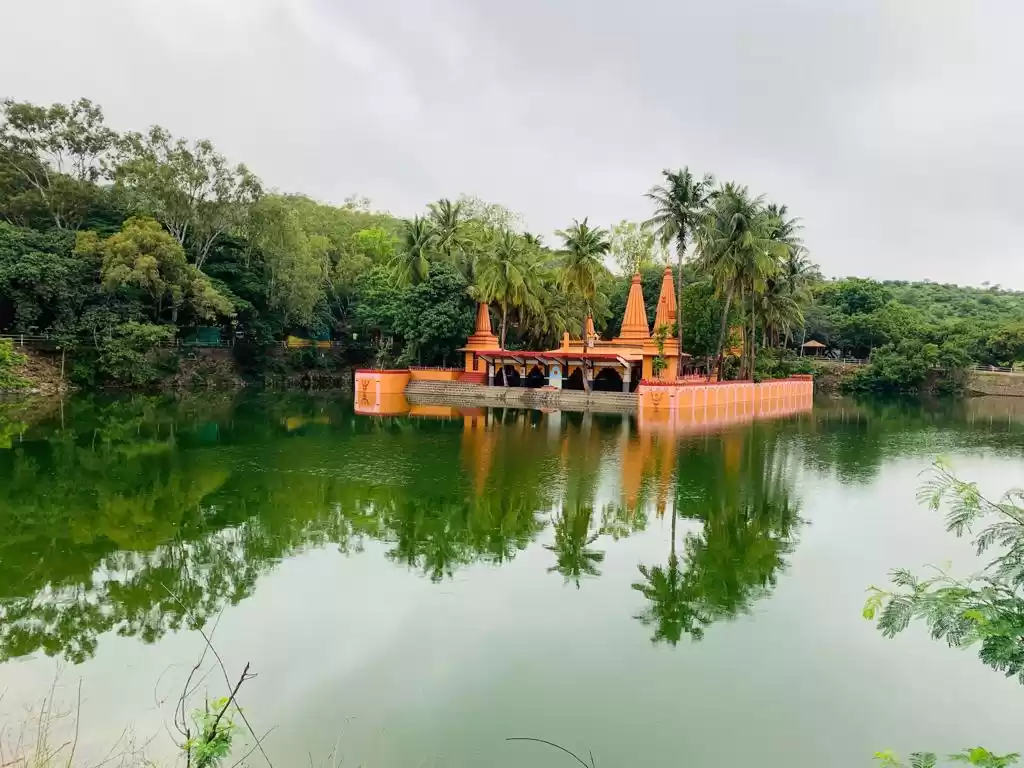Nestled in the rugged hills of the Junnar region in Maharashtra, the Lenyadri Ganpati Temple is not just an architectural marvel but also a sacred space deeply intertwined with mythology and devotion.
Unlike other temples in the Ashtavinayak circuit, Lenyadri is unique—it’s not a standalone structure but a cave carved into a hillside. The temple is believed to be the exact spot where Goddess Parvati gave birth to Lord Ganesha, making it one of the most revered sites for devotees and spiritual seekers.
In this article, we will explore the rich history, mythology, architecture, and significance of the Lenyadri Ganpati Temple, while also investigating the enduring belief that it is the divine birthplace of Lord Ganesha.
1. The Ashtavinayak Connection
Lenyadri is one of the eight temples forming the Ashtavinayak Yatra, a sacred pilgrimage for devotees of Lord Ganesha in Maharashtra. Each temple in the Ashtavinayak circuit has a distinct legend, iconography, and spiritual importance.
At Lenyadri, Lord Ganesha is revered as Girijatmaj, meaning “Son of Girija”—a divine name for Goddess Parvati. This temple is the sixth in the Ashtavinayak pilgrimage route, and unlike the others, it is carved into a mountain cave, offering a blend of natural beauty and religious heritage.
2. Mythological Origins: Lord Ganesha’s Birth at Lenyadri
The belief that Lenyadri is the birthplace of Lord Ganesha comes from ancient Hindu scriptures and Puranic stories. According to the Ganesha Purana, Goddess Parvati undertook a deep and austere penance inside these caves to be blessed with a child. Her devotion pleased Lord Shiva, and Parvati eventually created a child from the sandalwood paste she used for her bath.
She breathed life into the child, and thus, Lord Ganesha was born in the very cave that now houses the Ganpati idol. This is why he is known as Girijatmaj, emphasizing his origin from Girija (Parvati) and the divine act of creation performed by a mother.
3. Historical Background of the Lenyadri Caves
The Lenyadri Ganpati temple is set inside Cave No. 7 of the Lenyadri cave complex, which consists of 30 rock-cut caves dating back to the 1st to 3rd century AD. These caves were primarily Buddhist viharas and chaityas, indicating the region’s significance as a religious hub even before the rise of Ganpati worship in the area.
The conversion of one of these caves into a Hindu temple dedicated to Lord Ganesha reflects the evolving religious dynamics of the region. Over time, as Hinduism became more dominant in Western India, many of the Buddhist caves were repurposed, with Lenyadri being one of the finest examples of this transition
4. Cave Architecture and Rock-Cut Design
One of the most fascinating aspects of the Lenyadri Ganpati Temple is its rock-cut architecture. The temple is accessed by climbing 283 steps carved out of stone, leading to the entrance of the cave that houses the deity.
Inside, the sanctum is cut directly into the rock with no added materials. The temple lacks traditional ornamentation but possesses a stark simplicity that adds to its spiritual aura. The idol of Lord Ganesha is carved into the rock wall and is not a separate idol, a unique feature not found in most Indian temples.
Key features of the cave-temple architecture include:
- Rock-cut pillars with minimal decoration
- Flat ceiling with slight carvings
- Absence of a spire (shikhara), typical of cave temples
- Meditation cells surrounding the central sanctum, a remnant of its Buddhist origin
5. The Idol of Girijatmaj Ganesha
The idol of Lord Ganesha at Lenyadri is believed to be swayambhu (self-manifested). Unlike typical idols made of metal or stone, this one is naturally formed on the cave wall and appears in a meditative pose with no trunk turn, which is highly unusual for Ganpati idols.
The idol measures roughly 3.5 feet in height and 2.5 feet in width. Local legend says the idol grows slightly in size each year, although this remains a matter of faith.
Devotees offer prayers, modaks (sweet dumplings), and flowers here in hopes of receiving blessings for childbirth, knowledge, and the removal of obstacles.
6. Archaeological and Epigraphic Evidence
Archaeological surveys by the Archaeological Survey of India (ASI) confirm the Buddhist origins of the Lenyadri caves. Inscriptions in Brahmi script found in the caves date back to the Satavahana period, and mention donations by traders and monks for the upkeep of these caves.
However, there is no direct epigraphic evidence linking the cave to the birth of Lord Ganesha. The belief is entirely based on scriptural interpretation and oral tradition, which has been passed down over centuries.
Yet, the continued worship, historical transformation, and enduring faith have solidified Lenyadri’s identity as Ganesha’s birthplace in popular consciousness.
7. Religious Significance and Pilgrimage
For devotees, visiting the Lenyadri Ganpati Temple is not just about darshan (viewing the deity); it’s a deeply emotional and spiritual journey. Many couples seeking children visit this temple and perform rituals in the belief that Lord Ganesha, born here, will bless them with offspring.
The temple sees a massive influx of devotees during:
- Ganesh Chaturthi
- Maghi Ganesh Jayanti
- During the Ashtavinayak Yatra
These festivals are celebrated with fervor, rituals, music, and traditional Maharashtrian culture, making it a culturally rich spiritual destination.
8. Local Beliefs and Legends
Apart from the mainstream myth of Lord Ganesha’s birth, there are several local beliefs associated with the Lenyadri Ganpati temple:
- It is believed that the temple once had a tunnel leading to the Shivneri Fort, the birthplace of Chhatrapati Shivaji Maharaj, although this has never been proven.
- Villagers also say that wild animals never harm pilgrims on this hill, which is otherwise inhabited by monkeys and snakes.
- Some locals believe that the cave contains hidden energies, and meditating here can awaken spiritual consciousness.
9. Conservation Efforts and Tourism Impact
The site is protected under the Archaeological Survey of India, and efforts have been made to preserve its unique structure. However, increased tourism, lack of proper crowd management, and inadequate maintenance have occasionally threatened the site.
There are proposals to:
- Improve step safety and railing structures
- Provide eco-friendly amenities
- Install multilingual signboards
- Promote responsible tourism practices
These measures aim to ensure that the spirituality of the temple remains intact while still making it accessible for future generations.
10. How to Reach Lenyadri Ganpati Temple
- By Road: Located around 95 km from Pune and 182 km from Mumbai. Accessible via Junnar.
- Nearest Railway Station: Pune Junction
- By Air: Pune International Airport is the closest.
- Local Transport: Shared jeeps, autos, and private taxis from Junnar
The final stretch involves climbing nearly 300 steps, so visitors are advised to wear comfortable footwear and carry water.
11. Timings and Best Time to Visit
- Temple Timings:
- Morning: 6:00 AM to 1:00 PM
- Evening: 2:00 PM to 8:00 PM
- Best Time to Visit:
- November to February (cool weather)
- Visit during Ganesh Jayanti or Ganesh Chaturthi to experience the temple’s lively and festive ambiance.
12. Nearby Attractions
If you’re visiting Lenyadri, consider exploring:
- Shivneri Fort – Birthplace of Shivaji Maharaj
- Ozar Ganpati Temple – Another Ashtavinayak shrine, just 15 km away
- Naneghat – A historic mountain pass
- Junnar Caves – An extensive complex of ancient Buddhist rock-cut caves
These destinations add historical, cultural, and natural richness to your pilgrimage or travel itinerary.
13. Final Thoughts: Is Lenyadri Truly the Birthplace of Lord Ganesha?
Historically, there is no definitive archaeological proof of Lord Ganesha being born at Lenyadri. However, faith transcends facts, and the sheer power of devotion, passed on through centuries, has turned this cave temple into one of the most spiritually significant places in India.
Whether you’re a believer in mythology or a history enthusiast, the Lenyadri Ganpati Temple stands at the confluence of legend, devotion, and ancient art. Its ambiance, carved from stone and sanctified by stories, continues to draw seekers from all walks of life.
Frequently Asked Questions (FAQs)
Q. Is Lenyadri Ganpati Temple really the birthplace of Lord Ganesha?
A. Mythologically, yes. It is believed that Goddess Parvati gave birth to Lord Ganesha in this cave, earning him the name Girijatmaj.
Q. How old is the Lenyadri Ganpati Temple?
A. The caves date back to the 1st–3rd century AD, and the transformation into a Ganpati temple likely occurred during the later medieval period.
Q. Can elderly people climb the steps to the temple?
A. There are nearly 300 steps. Though manageable, it may be challenging for the elderly without support.
Q. Are there hotels near Lenyadri?
A. Basic lodging is available in Junnar. For better facilities, stay in Pune and make a day trip.



